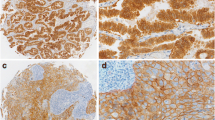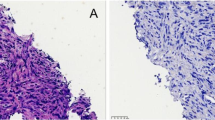Abstract
Hepatocyte Growth Factor (HGF) and its receptor c-Met are suggested to play an important role in progression of solid organ tumors by mediating cell motility, invasion and metastasis. Overexpression of HGF and c-Met have been shown in non-small-cell lung cancer (NSCLC). However, their role in tumor progression is not clearly defined. The aim of this study is to determine the role of HGF/c-Met pathway and its association with invasion related markers and clinicopathologic parameters in NSCLC. Immunohistochemical analysis was performed on 63 paraffin-embedded NSCLC tumor sections. The expressions of invasion related markers such as Matrix Metalloproteinases (MMPs) 2 and 9, Tissue Inhibitor Metalloproteinase (TIMP) 1 and 3 and RhoA were also examined. Co-expression of HGF/c-Met was significantly associated with lymph node invasion and TIMP-3 and RhoA overexpressions. There were positive correlation between TIMP-3 overexpression and advanced stage and negative correlation between RhoA overexpression and survival. DNA sequencing for Met mutations in both nonkinase and tyrosine kinase (TK) domain was established. A single nucleotide polymorphism (SNP) in sema domain and two SNPs in TK domain of c-Met were found. There was no statistically significant correlation between the presence of c-Met alterations and clinicopathologic parameters except shorter survival time in cases with two SNPs in TK domain. These results suggest that HGF/c-Met might exert their effects in tumor progression in association with RhoA and probably with TIMP-3. The blockade of the HGF/c-Met pathway with RhoA and/or TIMP-3 inhibitors may be an effective therapeutic target for NSCLC treatment.



Similar content being viewed by others
Abbreviations
- HGF:
-
Hepatocyte Growth Factor
- NSCLC:
-
Non-small cell lung cancer
- MMP:
-
Matrix metalloproteinases
- TIMP:
-
Tissue inhibitor of metalloproteinases
- ECM:
-
Extracellular matrix
- TK:
-
Tyrosine kinase
- JM:
-
Juxtamembrane
- TM:
-
Transmembrane
- SNP:
-
Single nucleotide polymorphism
- IHC:
-
Immunohistochemistry
References
Jemal A, Siegel R, Ward E et al (2006) Cancer statistics. CA Cancer J Clin 56:106–130
Ramalingam S, Belani C (2008) Systemic chemotherapy for advanced non-small cell lung cancer: recent advances and future directions. Oncologist 13:5–13
Okamoto I (2008) Overview of chemoradiation clinical trials for locally advanced non-small cell lung cancer in Japan. Int J Clin Oncol 13:112–116
Ma PC, Jagadeeswaran R, Jagadeesh S et al (2005) Functional expression and mutations of c-Met and its therapeutic inhibition with SU11274 and small interfering RNA in Non–small cell lung cancer. Cancer Res 65:1479–1488
Jiang WG, Martin TA, Parr C et al (2005) Hepatocyte growth factor, its receptor, and their potential value in cancer therapies. Crit Rev Oncol Hematol 53:35–69
Nakamura Y, Niki T, Goto A et al (2007) c-Met activation in lung adenocarcinoma tissues: an immunohistochemical analysis. Cancer Sci 98:1006–1013
Nakamura Y, Matsubara D, Goto A et al (2008) Constitutive activation of c-Met is correlated with c-Met overexpression and dependent on cell–matrix adhesion in lung adenocarcinoma cell lines. Cancer Sci 99:14–22
Stabile LP, Lyker JS, Land SR et al (2006) Transgenic mice overexpressing hepatocyte growth factor in the airways show increased susceptibility to lung cancer. Carcinogenesis 27:1547–1555
Pepper MS, Matsumoto K, Nakamura T et al (1992) Hepatocyte growth factor increases urokinase-type plasminogen activator (u-PA) and u-PA receptor expression in Madin–Darby canine kidney epithelial cells. J Biol Chem 267:20493–20496
Jeffers M, Rong S, Vande Woude GF (1996) Enhanced tumorigenicity and invasion-metastasis by hepatocyte growth factor/scatter factor-met signalling in human cells concomitant with induction of the urokinase proteolysis network. Mol Cell Biol 16:1115–1125
Lee KH, Hyun MS, Kim JR (2003) Growth factor-dependent activation of the MAPK pathway in human pancreatic cancer: MEK/ERK and p38 MAP kinase interaction in uP synthesis. Clin Exp Metastasis 20:499–505
Lorenzato A, Olivero M, Patanè S et al (2002) Novel somatic mutations of the MET oncogene in human carcinoma metastases activating cell motility and invasion. Cancer Res 62:7025–7030
Ma PC, Kijima T, Maulik G et al (2003) c-MET mutational analysis in small cell lung cancer: novel juxtamembrane domain mutations regulating cytoskeletal functions. Cancer Res 63:6272–6281
Ma PC, Tretiakova MS, MacKinnon AC et al (2008) Expression and mutational analysis of MET in human solid cancers. Genes Chromosomes Cancer 47:1025–1037
Kitajo H, Shibata T, Nagayasu H et al (2003) Rho regulates the hepatocyte growth factor/scatter factor-stimulated cell motility of human oral squamous cell carcinoma cells. Oncol Rep 10:1351–1356
Ridley AJ, Comoglio PM, Hall A (1995) Regulation of scatter factor/hepatocyte growth factor responses by Ras, Rac, and Rho in MDCK cells. Mol Cell Biol 5:1110–1122
Mizuno S, Matsumoto K, Li MY, Nakamura T (2005) HGF reduces advancing lung fibrosis in mice: a potential role for MMP-dependent myofibroblast apoptosis. FASEB J 19:580–582
Ide T, Kitajima Y, Miyoshi A et al (2006) Tumor-stromal cell interaction under hypoxia increases the invasiveness of pancreatic cancer cells through the hepatocyte growth factor/c-Met pathway. Int J Cancer 119:2750–2759
Wang SW, Pan SL, Peng CY et al (2007) CHM-1 inhibits hepatocyte growth factor-induced invasion of SK-Hep-1 human hepatocellular carcinoma cells by suppressing matrix metalloproteinase-9 expression. Cancer Lett 257:87–96
Passlick B, Sienel W, Seen-Hibler R et al (2000) Overexpression of matrix metalloproteinase 2 predicts unfavorable outcome in early-stage non-small cell lung cancer. Clin Cancer Res 6:3944–3948
Sienel W, Hellers J, Morresi-Hauf A et al (2003) Prognostic impact of matrix metalloproteinase-9 in operable non-small cell lung cancer. Int J Cancer 103:647–651
Suzuki M, Iizasa T, Fujisawa T et al (1998-99)Expression of matrix metalloproteinases and tissue inhibitor of matrix metalloproteinases in non-small-cell lung cancer. Invasion Metastasis 18:134–141
Thomas P, Khokha R, Shepherd FA et al (2000) Differential expression of matrix metalloproteinases and their inhibitors in non-small cell lung cancer. J Pathol 190:150–156
Gouyer V, Conti M, Devos P et al (2005) Tissue inhibitor of metalloproteinase 1 is an independent predictor of prognosis in patients with nonsmall cell lung carcinoma who undergo resection with curative intent. Cancer 103:1676–1684
Simi L, Andreani M, Davini F et al (2004) Simultaneous measurement of MMP9 and TIMP1 mRNA in human non small cell lung cancers by multiplexreal time RT-PCR. Lung Cancer 45:171–179
Aljada IS, Ramnath N, Donohue K et al (2004) Upregulation of tissue inhibitor of metalloproteinase-1 protein is associated with progression of human non-small- cell lung cancer. J Clin Oncol 22:3218–3229
Mino N, Takenaka K, Sonobe M et al (2007) Expression of tissue inhibitor of metalloproteinase-3 (TIMP-3) and its prognostic significance in resected non-small cell lung cancer. J Surg Oncol 95:250–257
Sobin LH, Wittekind C (2002) Lung. In: Sobin LH, Wittekind C (eds) UICC International Union Against Cancer. TNM classification of malignant tumours. 6th edn. Wiley-Liss, New York
Gilcrease MZ, Truong L, Brown RW (1996) Correlation of very late activation integrin and CD44 expression with extrarenal invasion and metastasis of renal cell carcinomas. Hum Pathol 27:1355–1360
Christensen JG, Burrows J, Salgia R (2005) c-Met as a target for human cancer and characterization of inhibitors for therapeutic intervention. Cancer Lett 225:1–26
Wang D, Sadée W (2006) Searching for polymorphisms that affect gene expression and mRNA processing: example ABCB1 (MDR1). The AAPS Journal 8:E515–E520
Kimchi-Sarfaty C, Oh JM, Kim IW et al (2007) A "Silent" polymorphism in the MDR1 gene changes substrate specificity. Science 315:525
Li XR, Ji F, Ouyang J et al (2006) Overexpression of RhoA is associated with poor prognosis in hepatocellular carcinoma. Eur J Surg Oncol 32:1130–1134
Nawrocki-Raby B, Gilles C, Polette M et al (2003) Upregulation of MMPs by soluble E-cadherin in human lung tumor cells. Int J Cancer 105:790–795
Castagnino P, Soriano JV, Montesano R, Bottaro DP (1998) Induction of tissue inhibitor of metalloproteinases-3 is a delayed early cellular response to hepatocyte growth factor. Oncogene 17:481–492
Kim SH, Choi HY, Lee J et al (2007) Elevated activities of MMP-2 in the non-tumorous lung tissues of curatively resected stage I NSCLC patients are associated with tumor recurrence and a poor survival. J Surg Oncol 95:337–346
Ahonene MA, Baker AH, Kaharl VM (1998) Adenovirus-mediated gene delivery of tissue inhibitor of metalloproteinases-3 inhibits invasion and induces apoptosis in melanoma cells. Cancer Res 58:2310–2315
Baker AH, George SJ, Zaltsman AB et al (1999) Inhibition of invasion and induction of apoptotic cell death of cancer cell lines by overexpression of TIMP-3. Br J Cancer 79:1347–1355
Miyazaki T, Kato H, Nakajima M et al (2004) An immunohistochemical study of TIMP-3 expression in oesophageal squamous cell carcinoma. B J Cancer 91:1556–1560
Yang T, Hawkes SP (1992) Role of the 21-kDa protein TIMP-3 in oncogenic transformation of cultured embryo fibroblasts. Proc Natl Acad Sci USA 89:10676–10680
Canovas D, Rennie IG, Nichols CE, Sisley K (2008) Local environmental influences on uveal melanoma. Cancer 112:1787–1794
Acknowledgements
This study was supported by Dokuz Eylul University Research Foundation, grant number 04.KB-SAG.085. The authors wish to thank Assoc. Prof. Belgin Unal for excellent help in statistical analysis.
Disclosure statement
All authors have no financial and personal relationships with other people or organizations that could inappropriately influence (bias) their work. All authors have read and approved the manuscript.
Author information
Authors and Affiliations
Corresponding author
Rights and permissions
About this article
Cite this article
Gumustekin, M., Kargi, A., Bulut, G. et al. HGF/c-Met Overexpressions, but not Met Mutation, Correlates with Progression of Non-small Cell Lung Cancer. Pathol. Oncol. Res. 18, 209–218 (2012). https://doi.org/10.1007/s12253-011-9430-7
Received:
Accepted:
Published:
Issue Date:
DOI: https://doi.org/10.1007/s12253-011-9430-7




